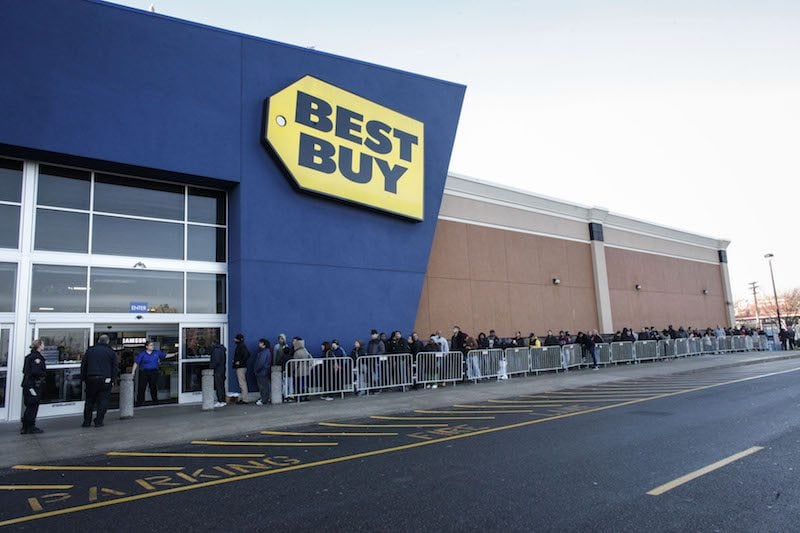15 Mistakes Too Many People Make When Buying a Computer
1. Not buying based on your needs
If you think a computer seems awesome because you’ve heard media hype about it, it’s the latest thing, or it just looks awesome, you’re probably shopping for a computer wrong. Sure, if you want to prioritize a certain aesthetic or as much power as possible, you can, but most of us should just think about what we need from the computer and buy a machine that will enable us to do what we need to do. If you’re going to just do light Internet browsing, some word processing, and watch a movie here and there, you can probably do without 32GB of RAM, that octa-core processor, or 25 USB 3.0 ports. Whatever you get with a computer, you pay for, so don’t pay for something you know you don’t need.
2. Believing a single number makes something better
When it comes to computer hardware, a lot — and I mean a whole lot — of numbers get thrown around, and an even greater amount of important numbers don’t even get mentioned. If you focus on one number, you might be ignoring a bunch of others. For example, a lot of people will assume an Intel Core i7 chip is better than a Core i5 chip, because duh, right? But there’s a lot more to the story — number of cores, number of threads, hyper-threading ability, cache size, and clock-speed. There are plenty of i5 chips that’ll knock the pants off plenty of i7 CPUs. The same scenario can arise for a lot of components. If you don’t know too much about computer components, we’ve got just the guide for you here. If you want to see how a specific component performs compared to another, check out thebenchmarks over at PassMark. A final word of wisdom on this topic: Bigger doesn’t mean better in computers.
3. Not knowing what you’re getting with an operating system
There are plenty of different computer operating systems (OS) out there — Windows, OS X, Linux, Chrome OS, to name a few — and while at first glance they might seem only aesthetically different, that couldn’t be further from the truth. Each functions differently, and most importantly for many users, handle software differently. If you have an old computer running one OS and want to bring software you purchased to a new computer, don’t expect to succeed if you switch operating systems. On top of that, you might not even be able to find a version of the software that will work on the new OS. For example, Skype may have versions working for Mac and Windows, but you won’t be able to video chat your friends and family if you switch over to Chrome OS. This calls back to the first point: you should decide what you need to do with the computer and ensure the OS will support it.
4. Assuming how a feature will work

Source: iStock
Let’s say you want Bluetooth and Wi-Fi on your new computer. Fine, that should be easy enough to find. Almost any laptop you find will have both, and both features aren’t too shy about showing up on desktop computers nowadays, either. Once you’ve got the computer with said features, they should just work, right? Maybe. A Bluetooth module in one computer isn’t always going to be the same the one found in another. They can be different generations, have different power requirements, have different effective ranges, and even behave differently simply because of the computer case they’re in. Wi-Fi, similarly, has a number of different classes and speeds, and you can’t assume they’ll all work in every situation. We’ll address how to avoid problems related to this in point No. 8.
5. Assuming a feature is even included
Computers come in all shapes, sizes, and configurations. You should never take anything for granted. If you want a computer with a CD/DVD drive, look and see if there is one, and if you’re in the store, press the button to make the tray open so you know with 100% certainty it’s there. Want audio? Make sure there are speakers and try playing something out of them. Hell, you should even take a peek around just to make sure there are USB ports. Whatever you know you want the computer to have, actually verify it’s there and in working order. Never assume. Never ever.
6. Ignoring missing details

Source: Thinkstock
“Oh, man! That computer comes with a Intel Core i7 CPU, an NVIDIA GeForce video card, and 8GB of RAM. Awesome!”
Hold the phone. Just as mentioned in the No. 2 on this list, all of that is only half the story. Why don’t we look at the rest of the story? That could be an i7 U 620 (a low-end dual-core processor), a GeForce 256 (a graphics processor from before Y2K), and the slowest clocked, lowest bandwidth, high-latency sticks of RAM anyone has ever heard of. You can’t be sure unless you check. Not only should you always check out the details, but you should be wary any time they aren’t presented front and center. Odds are, if the details aren’t mentioned, it’s because they’re not favorable details. If a computer is actually running some blazing fast quad-core CPU or some high end GeForce GTX video card, the seller would be a fool to hide those details.
7. Thinking components can be upgraded willy-nilly
One great thing about most desktops, and some laptops, is that there’s a lot of room to add or upgrade many components to improve your computer’s performance or keep it running smoothly as software demands increase with time. But alas, there can be quite a bit of complexity to it. Hardware changes quickly, and compatibility issues arise just as fast. Some components simply won’t work as upgrades; for instance, if you want to be able to upgrade your CPU eventually, you’ll have to check what kind of CPU socket is on your motherboard and find a new CPU that matches. If you want to add more RAM for a better multitasking experience, you’ll have to confirm you have free slots for the memory and that your OS supports as much RAM as you want to have.
Then there’s also the matter of bottlenecks. Some of the components you want to upgrade to might be blazing fast, but your current hardware might not support that speed. This is especially crucial if you want to upgrade the RAM or GPU right away when you buy a computer. Find out what clock speeds and bandwidths your computer can support, and don’t waste your money buying RAM or a GPU that runs any faster. That awesome 8GB stick of 3100MHz RAM is going to look like a whole lot of wasted money when your new computer throttles it down to 800MHz because you paired it with a second, much slower stick of RAM.
8. Not trying before buying
If you have the option to try out a machine a bit before you buy it, do it. If you’re buying one off the Internet but can go to a local store and test out the very same computer, do it. Try out the keyboard, mouse, touchscreen, and other important features. Make sure they feel good to you, because you might be stuck with some of them. Going back to point No. 5, if you see a component or feature, actually try it out. If something’s not readily available on the showroom floor (say you want to try out some desktop computer with an external touchscreen display), don’t be afraid to ask a salesperson about trying it out. Sure, they might say they can’t do that, but if they really want to sell the machine (and they probably do), there’s a good chance they’ll accommodate you. This is the point in the purchasing process that you want to make sure you don’t hate the thing and that you’ll probably be able to tolerate it, at the very least.
9. Not trying it out enough after buying

Better to find a problem with a computer while you can still return it | Source: iStock
Just because you’ve traded your money for a new computer already doesn’t mean the buying process is over. While you’re still in the time window where you can return the device if it’s not up to snuff, you had best throw on “Take It To The Limit” on your stereo, set up the new computer, and take it to the limit. Test everything. See how far the Bluetooth signal reaches before it starts breaking down. Ensure it can connect to your Wi-Fi network and maintain a consistent connection. Test out all of the drives. Stick something into every single USB port. Try out headphones and microphones. Install all of the programs you want to use and try them them out. Hard. Run the most demanding video game you can get your hands on at the highest settings and keep playing for hours on end. You basically want to make sure that the computer will easily meet or slightly exceed your needs. If it’s falling short or not working how you expect, you want to find that out while you can still return it. (Personal war story: I once bought a desktop computer that seemed awesome, but when I gamed on it, it kept crashing, likely because the power supply was insufficient. I returned it quickly for a replacement. The new computer had a CD/DVD drive, but it wasn’t actually set up and wouldn’t open. So I returned that one. If I hadn’t tested out those features early on, I would have learned the hard way what it felt like to waste $800.)
10. Always buying whatever’s cheapest
If you have very minimal computer demands and hardly browse the Internet, you might be able to get away with only ever getting cheap computers. But not everyone will, and those that try can have it come back to bite them in the rear. Cheap and old hardware is going to more quickly wear out and fail to meet the ever increasing demands of new software. A $200 machine could last you a couple of years, but that time may be filled with headaches as it begins to struggle more and more on its way to the computer graveyard. A $400 computer bought at the same time could last a fair bit longer, and that whole time should be less filled with headaches. That said, it can be nearly impossible to be entirely sure what you’re going to get for your money, but you’ll probably have a good chance of finding a more reliable, longer-lasting PC if you spend a bit more. You don’t need to buy any $2,000 computer, but just keep an eye out for good deals on brands and models that have proven to have a good lifespan, and you should be safe.
11. Not being aware of software trials

Windows 10 | Microsoft
Plenty of computer will come with software advertised as pre-installed. And indeed that software may be present. But it might not be what you expect. Software trials are pretty common, and they can be for anything from a photo editor or virus scanner to the computer’s OS. It might not be common for a computer to come with only a trial version of an operating system, but there are some out there, so be sure to find out the details before you buy. A license for Windows can cost around $100, and that’d be a large unexpected expense. Trials for other software are pretty common, though, and you should confirm what is and isn’t a trial before you decide if a computer is worth the price. (Hint: You should think of trials as worth $0.)
12. Buying at the wrong time

Calendar | Source: iStock
There are a lot of factors to consider when figuring out when to buy a computer. The most important, of course, will be your need. If you need one right this minute, then your hands are tied. But if you can wait, or if you know your current computer is on its last leg, a bit of wiggle room can make a big difference in what you pay for your new computer. First off, there are tons of deals on computers all the time. Tech retailers and manufacturers have all sorts of deals, and if you stay vigilant, you might see the PC you’re hoping to buy on sale. Product cycles can also come into play. Just like with smartphones, there are constantly newer versions in series of computers coming out, or newer hardware supplanting the ever-so-slightly older hardware. If you do your homework, you may be able to figure out when something new is going to come out. If you buy right before it does, you’ll likely be wasting money. After that new device or hardware comes out, the older hardware should drop in price — leaving you with the option of buying the old hardware cheaper, or buying the new hardware at around the same price you’d have paid if you bought the old hardware too early.
13. Not shopping around enough

When computer shopping, visit as many stores as you can to find the best options and deals | Kena Betancur/Getty Images
While there’s no one place you need to shop at, you do need to shop at many places — that is, if you want to get the best deal. Don’t just go into Best Buy and assume your options are limited to those devices at those prices. Shopping at a single retailers (especially a brick-and-mortar shop) will guarantee that you’ll miss out. As mentioned in No. 11, there are lots of deals out there. Pretty much every big retailer is going to have some deal going at at any given time, so you’ve just got to hunt for the right one, which means checking way more than one place. Check Newegg. Check TigerDirect. Check Amazon. Check BestBuy. Check SuperBiiz. Check the manufacturers’ websites. Check all the other retailers I can’t list here. If you shop around regularly, and are patient, you’ll probably get an excellent deal on a new computer.
14. Not asking for free stuff

Keyboards | Source: Amazon
Why wouldn’t you want free stuff? If you’re buying on the Internet, you might have a harder time getting free stuff, since there’s no salesman to haggle with, but if you end up buying in a brick-and-mortar store, try to get something (or a few things) thrown into the bargain. If you’re buying a desktop, you know you’ll need a keyboard, mouse, and monitor, so try to get them thrown into the deal for free or for a discount. Frequently, computers come with free printers. If you’re not offered one, ask for one. Whatever you’re trying to get with the computer, be sure it’s within reason (you’re not going to convince them to give you a second computer for free if you purchase one), and act like you’re not quite sold on the machine unless you can get the free thing thrown in. Even if you don’t actually get anything, it can’t hurt to ask, and you’ll probably get offered some discounts at the very least.
15. Letting the security trial expire

Computer security | Source: iStock
Sure, I know, this comes a while after you buy the computer. But it’s a mistake closely linked with your purchase. Why? Because letting the trial for your virus scanner expire puts that new purchase at a greater risk of going sour. A bad virus can turn a great computer into a great paper weight, so do keep yours machine protected. You can buy a subscription to the trial service that (likely) comes with your computer, or you can replace it with afree security system like AVG. Whatever you do, don’t ignore the need for up-to-date security software.
Finally, there’s the matter of expensive setup services and warranties. This isn’t getting its own point, because we’re not going to call either a mistake. Choosing to get a warranty is an extra cost, but adds some security. If you’re concerned about potential damage to the computer, a warranty isn’t a bad idea. As far as setup services, if you know your way around a computer all right, or know someone who does and is willing to help, you can likely pass on having a professional set it up — most of what’s done is pretty simple. If everything about computers is like a foreign language to you and no one you know tolerates your technological limp, it may be worth the money to have a pro come set up your new computer and get you off the ground.
By avoiding the mistakes on this list, you can avoid a lot of headaches and spending more money than necessary on a new computer.







Comments